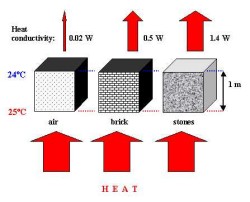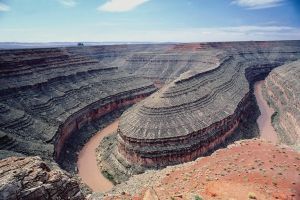|
|
 |
|
|
|
 |
| |
|
|
 |
Urban Climate
Read more |
Heat balance in a city
People living in a city sometimes have an impression that the city centre is warmer than the suburbs. How is air warmed in a city? What role is played by the buildings' structure (e.g. urban canyons)? |
|
|
|
|
 |
|
The radiation balance and the heat balance are closely correlated with each other. First the short-wave solar radiation reaches the surface of the earth. A part of it is absorbed there and then emitted as a long-wave radiation (i.e. heat) to the atmosphere. Therefore, the air is mainly warmed by the ground, not directly by the Sun.
|
Natural surface
The heat balance of a given natural surface such as a meadow, is the difference between the energy gained and lost due to the exchange described by the following formula:
Q + H + E + G = 0
where:
Q - net all-wave radiation (described in detail in the text "Radiation balance" in this unit)
H - turbulent sensible heat, absorbed or transmitted by the air or earth during a change of temperature
E - turbulent latent heat, released or absorbed during a change of state of water (e.g. evaporation involves absorption of energy while condensation involves a release of energy)
G - heat transported by the conduction in the ground
|
 |
 |
 |
|
1. Heat emitted to the atmosphere in a non-urban areas
author: Sebastian Wypych
|
|
|
The term "turbulent" means that the heat is transferred by turbulent air motions, i.e. random and continuously changing air motions, which are superposed on the mean motion of the air.
|
 |
 |
|
2. Sunrise and sunset mark the moments when the directions of heat flow begin to change
Source: www.freefoto.com
|
|
 |
Please note that during a day-time, the signs are different than during the night-time, indicating the direction of heat transfer:
Day-time: the air is colder than the ground (it warms more slowly), so the heat transfer tends to diminish the difference and warm the air, the radiation stream (Q) is directed from the ground toward the atmosphere (positive value):
Q - H - E - G = 0
Night-time: there is no sunshine and no energy delivery to the Earth surface, the heat will go from atmosphere to the ground (Q has the negative value). Usually, during a night, the ground cools more than the air, as the air cools more slowly:
- Q + H + E + G = 0 |
Urban surface
The heat balance of an urban area is more complex due to the volume of buildings. Thus, the heat balance for an urban area must include a storage term Qp for heat which includes heat exchange by the conduction in ground, streets, walls of the buildings:
Q + Qp + H + E + Qf = 0
as well as a term Qf to represent the anthropogenic heat delivered to the atmosphere mainly during combustion of fossil fuels.
Please note that we do not take here into account the influence of the air masses coming to the city and also bringing some heat, i.e. the influence of advection, but if we assume that a city is a rather uniform landuse type area, then the advection is negligible. |
 |
 |
|
3. Heat emitted to the atmosphere in a city
Author: Sebastian Wypych
|
Additional heat
Most materials used to build a city are characterised by high thermal conductivity (with units W/m/K) which means that lots of heat can go quickly through it, from the surface toward deeper parts. Therefore, a city cools down much more slowly during the night than non-urban areas. The materials used to build a city are characterised also by high thermal admittance (with units J/m2/s0.5/K), which is the ability of a surface to accept or release heat, i.e. it is the temperature change produced by a given heat flux change. Huge factories, such as steel-works, emit enormous amounts of heat. On average, one such factory can deliver every day to the urban atmosphere four times more energy than the incoming solar radiation. In a yearly cycle, the intensity of anthropogenic heat emission changes in the same way as the intensity of urban heat island. However, in cold climates in winter domestic heating and fossil fuel burning can result in greater energy input than from the Sun, while in hot climates air conditioning adds another heat load to an already hot air.
|
 |
 |
 |
|
4. Thermal conductivity of different materials
Please click to see enlarged image! (39 K)
Author: Anita Bokwa
|
|
|
|
 |
 |
 |
5. Urban canyon (to the left) and natural canyon (above)
photo: Sebastian Wypych (to the left)
Source: CorelDRAW! (above) |
|
|
An important element of urban structure are so-called urban canyons, i.e. streets with rows of high buildings on both sides, analogous to river canyons. The amount of solar radiation received by an urban canyon as a whole depends on the height of the buildings and on the orientation of the canyon. Further, the properties of the materials used for the construction of buildings and streets are important, not only due to their thermal admittance, but also in terms of their short-wave reflectivity or albedo. A phenomenon known as solar trapping can occur in canyons whereby the solar radiation is reflected off many surfaces within the canyon, thus allowing more opportunity for absorption (have a look at the concept of sky view factor). About 60% of the net all-wave radiation is released to the air as sensible heat and 30% is stored in the walls and streets. Only the remaining 10% is used for evaporation, as the artificial surfaces do not store water like natural ones do, and there is usually little green areas in a city. However, the mentioned numbers may vary for different cities due to amount of greenspace, irrigation etc.
|
|
About this page:
Authors: Sebastian Wypych, Anita Bokwa - Jagiellonian University - Cracow / Poland
Supporter: Anna Gorol
1. Scientific reviewer: Prof. Barbara Obrebska-Starkel - Jagiellonian University - Cracow / Poland - 2003-06-20
2. Scientific reviewer: Dr. Marek Nowosad - Maria Curie-Sklodowska University - Lublin / Poland - 2003-06-16
3. Scientific reviewer: Rachel Spronken-Smith - University of Canterbury - Christchurch / New Zealand - 2003-10-29
educational reviewing:
last update: 2003-11-22
|
|
 |
|









